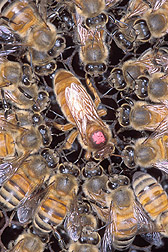This page has been archived and is being provided for reference purposes only. The page is no longer being updated, and therefore, links on the page may be invalid.
Africanized Honey Bees Are Still on the Move
By Kim KaplanMarch 6, 2006
In 2005, Africanized honey bees showed up for the first time in Louisiana, Arkansas and Florida. An updated map showing the spread of Africanized honey bees by county and state has been posted on the Agricultural Research Service (ARS) website at www.ars.usda.gov/ahbmap/.
The arrival in Florida was not contiguous with the bees' spread from the Southwest. It was most likely a result of human-assisted transport, by which trucks, ships, railroad cars or other types of transportation inadvertently bring Africanized honey bees into new areas.
Usually, human-assisted transport finds are not considered part of Africanized honey bees' spread. But because they have been found in 14 counties, the state of Florida now considers Africanized honey bees to be established there.
The ARS Carl Hayden Bee Research Center in Tucson, Ariz., is responsible for official identifications of Africanized honey bees, especially when the bees are found in new states. Additional information about ARS research on Africanized honey bees can be accessed at gears.tucson.ars.ag.gov/.
Among ARS' recent research accomplishments related to the bees is new guidance for beekeepers on the best time to requeen hives to reverse Africanization of honey bee colonies. Queens of known genetics, from reputable breeders, should be introduced into hives in the fall to give them the best chance of being accepted by the bee colony.
ARS is the U.S. Department of Agriculture's chief scientific research agency.

